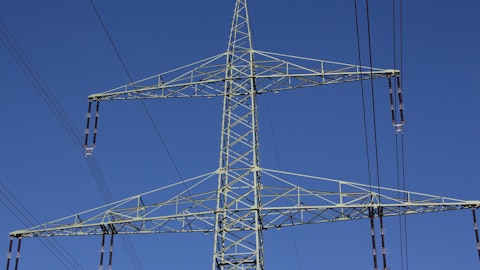I can respectfully disagree with that view. I think SCE had factored that in. And what’s ironic about it is that that very same week, actually a few days before the PUC voted out that final decision, the governor unfortunately cut out something like $200 million from his budget proposal for building electrification. And so to me that just shows that here say one of the key gaps as we identified in our Mind the Gap white paper a few years ago, building electrification, if you think about total greenhouse gas emissions in the state, buildings account for about 10% of greenhouse gas emissions, but we saw building electrification being able to make up about a quarter of the gap that we saw in terms of newly carbonization steps needed between we filed that or published our white paper two, three years ago in 2030.
So sorry for the long preamble, but it kind of gives you context of how important we think building electrification is. So what do we do now? Well, for us, let me just remind you that that denial of DEA doesn’t impact at all the 5% to 7% EPS growth targets we have for ‘25 and for ‘28, that would have been incremental on top of that. And it certainly does not impact the merit of SCE’s ‘25 GRC application because the infrastructure investment that’s called for there is absolutely needed regardless of what happened with the, but our team will continue to look at how is the gap shaping up for the state, how is the state doing in terms of meeting its 2030 legislative target of a 40% economy-wide reduction in greenhouse gas emissions from 1990 and the levels, how is the state doing in terms of getting to net zero by 2045 and we expect we’ll continue to see building electrification being a laggard in terms of the progress in the state so our team is already thinking about are there other opportunities to help the state help itself and whether that’s another application like this one, we certainly wouldn’t go back out with the same thing at no point to that but we’ll continue to think creatively about is it an application standalone, are other funding sources that can be tapped that might be existing today but that maybe haven’t been quite fully tapped yet, are there things that SCE can do to utility, are there things that SCE can encourage others to do to help address the gap thinking about the whole space right now and we’ll keep you posted.
Does that help, David?
David Arcaro: Yes, that’s the helpful perspective, doesn’t seem like the opportunity goes away.
Pedro Pizarro: Well, the need certainly doesn’t go away, today it’s increasing.
David Arcaro: Right, yes, make sense. No great and then I guess my only other kind of lingering question here maybe I’ll have to follow up separately but just on that cost excluded from authorized sorry Marie to go back to this but just are there any other moving pieces in that $0.25 versus the last slide deck. Did the amount of wildfire claim debt go up meaningfully? I would have thought that was not changing too much kind of quarter-to-quarter here and then it looked like the interest rate assumption was flat between the two slides there. So sorry just curious if there’s anything else there is missing?
Maria Rigatti: So if you’ll recall that in Q3 we did — when we did have the more sizable increase in the reserve, we didn’t really update every single line item in the 2025 rack-up because we knew that we would be able to manage within the range. So but now that we’ve got the CCM sort of, as I said, integrated into our tariffs, it’ll be implemented in rates, we wanted to go through line by line and provide a fresher update. So that’s what’s going on.
Operator: Our next question will come from Julien Dumoulin-Smith with Bank of America.
Julien Smith: Hey. Good afternoon, team. Thank you very much for the time. Appreciate it. Hey. Thank you. So let me just ask a little bit of a follow-up from Angie here vis-a-vis the cost of capital here. Just when you think about it, maybe in the reverse here, if you will, if there were to be further gyrations on the cost of capital, it sounds like they’re puts and takes that you could manage around here to keep numbers intact, right? I get that the full extent upwards wasn’t necessarily reflected in the linear fashion in the outlook for a variety of reasons. I just wanted to clarify that piece, and then I got a quick follow-up on the long term here. And I got folded into a lot.
Maria Rigatti: Okay. So, Julien, I think that actually if you think about what happened in 2023, where we managed the variability that we saw in the business and came out at $4.76, which is above the midpoint of our guidance range, we always have things that we’re managing in the business, and we would do that to the extent that we needed to relative to the cost of capital. But I want to just re-emphasize. The cost of capital mechanism triggered because of the interest rate environment we’re in. Like, I’ll reflect again that the energy division did disposition our advice letter and indicated that the change would be implemented. They went through and responded to all of the intervener commentary around sort of interveners perspectives on why they think it shouldn’t be implemented and they did a very thorough job of responding to each point.
It does now have to be resolved through the CPUC writ large but none of the facts have changed and we continue to move forward with it and again it’s in our tariff sheets and it will be implemented in our next rate change.
Pedro Pizarro: And I would just use it as an opportunity a little shameless plug but this kind of goes back to page 3 in the deck. We manage the business. We have met or exceeded our guidance for the last two decades and we plan to continue doing that Julien.
Julien Smith: I hear you on that one. Excellent and well done. Maybe just speaking of guidance and long-term outlooks just real quickly on the EPS profile. So you have this ‘25 to ‘28. We’ve talked a little bit with Jeremy earlier about the continuity of that $0.37 from ‘25 into ‘26. How do you think about the earnings profile from ‘25 to ’28? That might go back to some of the variances, the cadence, the GRC itself, any comments that you offer?
Maria Rigatti: Sure. And I think I just want to reiterate that $0.37, it’s part of our rate base in each year. So if you do the rate based math, the way you’ve always done it, you’ll capture that true-up and the ongoing impact of that. So I just want to make sure I say that one more time to clarify for folks. In terms of the ongoing through 2028 trajectory, I’m going to take it back again to rate based math. Earnings here are driven by rate based. And we see that growth trajectory all the way through 2028. We’ve given you the range, we’ve given you the numbers that relate to the request. We’ve given you some sensitivities around what the moving pieces are. But fundamentally, the wildfire claims debt expense has stabilized, right, because now we’re getting to the tail end of all of that.
So that’s stabilized. It doesn’t create that not in the beginning, but in at the end sort of dynamic we had in 2021 through 2025. And as we’ve said before, O&M efficiencies are not a driver for ‘25 through ‘28.
Pedro Pizarro: Yes. And Julien, again, same thing for ‘28 is for ‘25. We’ve shared with you our target of 5% to 7% growth rate through ‘28. And our growth rate will be someplace in that 5% to 7% range. For ‘25, you’re going to see a growth rate for us. It’s going to be 5% to 7%. It’s not 3%, it’s not 4%, it’s going to be 5% to 7%. So we’re going to meet our guidance and deliver on our expectations for you all.
Operator: Thank you. I will now turn the call back over to Sam Ramaraj for closing remarks.
Sam Ramraj: Thanks for joining us. This concludes the conference call. Have a good rest of the day. You may now disconnect.
Follow Edison International (NYSE:EIX)
Follow Edison International (NYSE:EIX)
Receive real-time insider trading and news alerts





